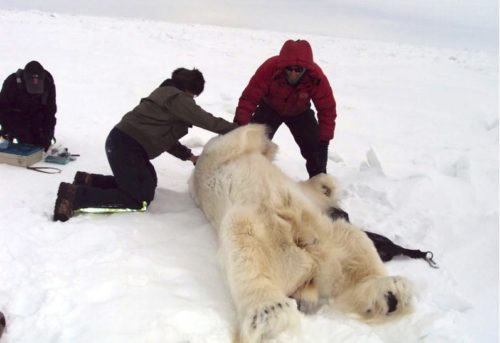Polar bear researchers have been doing capture/recapture studies in Western Hudson Bay for decades yet most of the data claimed to be critical for assessing effects of human-caused global warming on this species have not been published.
I raised this point in one of my early blog posts (27 Sept 2012) but the situation has not changed in 6 years. Here’s an update.
Years ago now, in an oft-cited paper, Stirling and Derocher (2012) claimed to summarize the evidence that climate warming was negatively impacting polar bear health and survival. Several life history parameters were considered crucial, particularly body condition.
Despite almost a dozen papers (and perhaps more) on various aspects of WH polar bear health and life history studies based on capture/recapture data published since 2004 (e.g. Castro de la Guardia 2017; Lunn et al. 2016; Pilfold et al. 2017), none have reported the body condition data that supposedly support the claim that sea ice loss is having a severe impact — and the same is true for litter size, proportion of independent yearlings, and cub survival.1
BODY CONDITION STUDIES
There has been no more recent data published on body mass of lone females since 2004, or of adult males and females with cubs in WH since 1998 — 20 years ago — (Stirling et al. 1999:296; Stirling and Parkinson 2006:265), even though this is the data (declining weights of bears) that is said to show sea ice loss due to human-caused global warming has been negatively impacting WH polar bears since 1985.
For example, in their review of body condition evidence, Stirling and Derocher (2012) added data for 2005-2007 to those collected by Stirling and Parkinson (2006), in the figure they presented for the mass of lone female bears (see their Fig. 5 below) but cited “unpublished data.”
This means Nick Lunn and Ian Stirling had the data for 2005-2007 but by 2012, still hadn’t bothered to publish it in any peer-reviewed literature. They still haven’t.
Nor have they or anyone else published any of the body condition data collected since 2007, despite the public handwringing from Derocher and Stirling (e.g. here and here) about weight loss due to reduced sea ice since then.
A hint as to why the recent data hasn’t been published is right there in the Stirling and Derocher (2012) graph: of those three years of added unpublished data, only one year’s value (2006) fit the trend line of a decline: the other two had values as high as the 1980s.

The result: the overall decline from 1980 to 2007 was only 20%, compared to a 22% decline based on the 1980-2004 data.
RECORDING BODY MASS IS STANDARD PROTOCOL
Since recording body mass is part of taking standard morphometric data for polar bears (Derocher and Stirling 1995; Obbard et al. 2016), this critical data must exist for all years after 2007 for Western Hudson Bay but has simply not be reported.2
If more recent data is similar to 2005-2007 or better, it’s no mystery why it has been kept secret: evidence that bears have been as heavy (or heavier) in recent years than in the late 1990s to early 2000s would not fit the climate change catastrophe narrative.
Previous research in WH (Derocher et al. 1992) on animals captured between 1982 and 1990 suggested that the critical mass for lone females (presumed pregnant) was about 189 kg: that is, below this weight, females could not maintain a pregnancy.
That means that the reduced mass of lone females in the mid-2000s (230-236 kg) was still a long way from the number that was a known cause for critical concern regarding the maintenance of population size.
One recent published paper Sciullo et al. (2016) assessed body condition of polar bears using subjective fatness indices, the lipid content of adipose tissue, energy density models, and something called “bioelectrical impedance analysis” (BIA), none of which were used between 1980 and 2007.
Note that without being able to compare such data to earlier values, such studies are useless for assessing impacts of global warming but are useful for generating graduate degree topics for university students.
However, even the new body condition proxy data generated by Sciullo et al. (2016:54) for 2012 and 2013 did not correlate well with the earlier breakup or later freeze-up of sea ice in Western Hudson Bay:
“…we found sea ice to influence body condition metrics across age and sex classes. The differing response of various metrics to changing ice conditions, however, suggests that timing of breakup and freezeup may not be the sole factors involved in influencing polar bear body condition. For example, energy density, storage energy and skull width declined over time in solitary adult females (Fig. 7), but these metrics were not predicted by sea ice breakup or freeze-up dates.” [my bold]
In other words, researchers have been trying new metrics to assess body condition rather than measuring and reporting body mass, but the data haven’t provided any evidence for a continued decrease in body condition that correlates to earlier sea ice breakup and/or later freeze-up.
In fact, capture/recapture data collection continues to this day in WH (see 2018 tweets from Derocher below), but none of the data on mass of bears collected since 2004 has been published.
Satellite-linked ear tag radio deployed on adult male #polarbear today on the sea ice in Hudson Bay. We use these to monitor habitat use & effects of sea ice loss due to climate change. @ualbertaScience project based from @ChurchillNSC pic.twitter.com/kQxXieme5a
— Andrew Derocher (@AEDerocher) April 20, 2018
We caught this 22 year old male #polarbear 100 km east of Churchill in Hudson Bay yesterday. 1st caught as a 2 year old. Old bears often lose pigment in their claws. @ualbertaScience crew waiting out a storm today after a week of VERY warm weather. Cold will help us & the bears. pic.twitter.com/vTXQHiIlsV
— Andrew Derocher (@AEDerocher) April 22, 2018
I confess: I love being out on the sea ice learning more about #polarbears & how they make a living out there. The best part? No deniers. Only the bears. Checking the tooth wear & canine breakage on this bear. pic.twitter.com/hatPEOhZGX
— Andrew Derocher (@AEDerocher) April 29, 2018
CONCLUSION
Eventually, some journalist or reviewer will ask to see the body mass data. Western Hudson Bay researcher Andrew Derocher’s enthusiasm for the value of location data of captured, tagged and collared bears every year is a smoke-screen for the data he isn’t showing.
In the tweet below (24 May 2018), Derocher states the length of time ashore is correlated to “survival and reproduction” but no paper describing such a long-term relationship has been published in the last 20 years.
As the melt in Hudson Bay progresses, most #polarbears we’re tracking are near the west coast: a typical pattern. One outlier is well to the east. We’re monitoring is the date the bears move onto shore: onland period length is correlated with survival & reproduction. pic.twitter.com/QrxQMkMcPC
— Andrew Derocher (@AEDerocher) May 24, 2018
Bottom line: Derocher and his students keep collecting raw data on body mass but don’t publish the results. Derocher and colleague Nick Lunn keep insisting loss of body fat is an indicator of sea ice loss (see here, here and here) but they don’t publish the body weight (mass) data.
Read rest at Polar Bear Science




















When the data doesn’t support a liberal cause, it is common for the researchers to keep it secrete. You can bet if the polar bear data supported the idea that the bears were in trouble, it would have been published a long time ago.
There are other areas inside and outside the climate change issue where data is not released because it doesn’t support a political cause. I believe it was in the mid 1980’s that a researcher gathered data and published results saying that gun control would save lives. However, he refused to release the data or his methods of analysis despite countless requests for the information. He basically said I’m the scientist so trust me.
The original paper on ocean acidification picked the year 1988 as their base line. This was a high point of ocean pH (least acid) which guaranteed that all other years would be more acid by comparison. For the years previous to 1988 they used computer simulations even though they had the real world data. Since the real world data has been found by another researcher and it clearly shows that there isn’t a pattern of the ocean becoming more acid.
The lie! “data that supposedly support the claim that sea ice loss is having a severe impact — and the same is true for litter size, proportion of independent yearlings, and cub survival.”
The truth! “We caught this 22 year old male #polarbear 100 km east of Churchill in Hudson Bay yesterday. 1st caught as a 2 year old.”
What? He appears to be “normal”, even after years of unnecessary traumatic harassment.